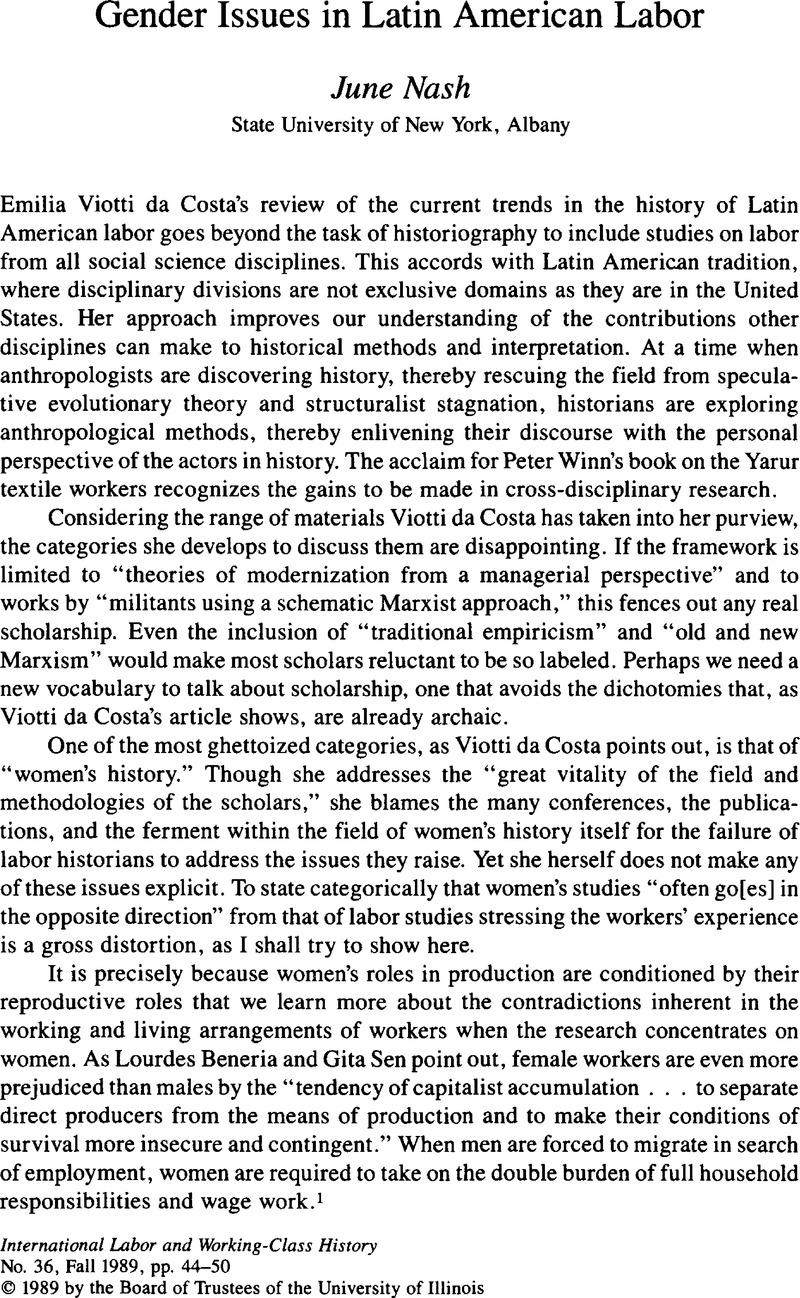Published online by Cambridge University Press: 16 December 2008

1. Beneria, Lourdes and Sen, Gita, “Accumulation, Reproduction, and Women's Role in Economic Development,” Feminist Studies 8 (Spring 1981): 288.Google Scholar
2. Saffioti, Heleieth Iara Bongiovani, Women in Class Society (New York, 1969)Google Scholar; and Jelin, Elizabeth, “The Bahiana in the Labor Force in Salvador, Brazil,” in Women and Change in Latin America, ed. Nash, June and Safa, Helen (South Hadley, 1986), 129–46.Google Scholar
3. Schmink, Marianne, “Women and Urban Industrial Development in Brazil,”Google Scholar in Nash, and Safa, , eds., Women and Change in Latin America, 136–64.Google Scholar
4. Sautu, Ruth, “The Female Labor Force in Argentina, Bolivia, and Paraguay,” Latin American Research Review 16 (1981): 152–59Google Scholar; Figueroa, Teresa Ortego de, “A Critical Analysis of Latin American Programs to Integrate Women in Development,” in Women and World Development, ed. Tinker, Irene and Bramsen, Michele Bo (Washington, 1976), 429–76Google Scholar; Safa, Helen, “Runaway Shops and Female Employment: The Search for Cheap Labor,” Signs 7 (Winter 1981): 418–33CrossRefGoogle Scholar; and Fernandez-Kelley, M. Patricia, For We are Sold, I and my People: Women and Industry in Mexico's Frontier (Albany, 1983).Google Scholar
5. Saffioti, Heleieth Iara Bongiovani, “Technological Change in Brazil: Its Effect on Men and Women in Two Firms,”Google Scholar in Nash, and Safa, , eds., Women and Change in Latin America, 109–35Google Scholar; and Alonso, José A., “The Domestic Clothing Workers in the Mexican Metropolis and Their Relations to Dependent Capitalism,” in Women, Men, and the International Division of Labor, ed. Nash, June and Fernandez-Kelly, M. Patricia (Albany, 1984), 161–72.Google Scholar
6. Aguiar, Neuma, “Research Guidelines: How to Study Women's Work in Latin America,”Google Scholar in Nash, and Safa, , eds., Women and Change in Latin America, 22–34.Google Scholar
7. Bourque, Susan C. and Warren, Kay Barbara, Women of the Andes: Patriarchy and Social Change in Two Peruvian Villages (Ann Arbor, 1981).CrossRefGoogle Scholar
8. Nash, June, “Implications of Technological Change for Household Level and Rural Development,” in Technological Change and Rural Development in Developing Countries, ed. Weil, Peter M. and Elterich, J. (Newark, Del., 1982), 429–76.Google Scholar
9. Rubbo, Anna, “The Spread of Capitalism in Rural Colombia: Effects on Poor Women,” in Toward an Anthropology of Women, ed. Reiter, Rayna R. (New York, 1975), 333–58.Google Scholar
10. Buechler, Judith-Maria, “Women in Petty Commodity Production in La Paz, Bolivia,”Google Scholar in Nash, and Safa, , eds., Women and Change in Latin America, 165–89.Google Scholar
11. Sautu, , “Female Labor Force.”Google Scholar
12. Archetti, Eduardo and Stolen, Kristi Anne, “Economía Doméstica, Estrategias de Herencia y Acumulación de Capital: La Situación de la Mujer en el Norte de Santa Fe, Argentina,” América Indigena 38 (04–06 1978): 383–403.Google Scholar
13. Arizpe, Lourdes and Aranda, Josefina, “The ‘Comparative Advantages’ of Women's Disadvantages: Women Workers in the Strawberry Export Agribusiness in Mexico,” Signs 7 (Winter 1981): 453–73.CrossRefGoogle Scholar
14. Safa, , “Runaway Shops,” 433.Google Scholar
15. Buvenic, Myra, Lycette, Margaret A., and McGreevey, Paul, Women and Poverty in the Third World (Baltimore, 1983).Google Scholar
16. Arizpe, Lourdes, “Women in the Informal Labor Sector: The Case of Mexico City,” Signs 3 (Autumn 1977): 25–37CrossRefGoogle Scholar; Bolles, Lynn, “Female Headed Households in Urban Jamaica,”Google Scholar in Nash, and Safa, , eds., Women and Change in Latin America, 65–83.Google Scholar
17. Portes, Alejandro and Walton, John, Labor, Class, and the International System (New York, 1981)Google Scholar; Bunster, Ximena, Chaney, Elsa, and Young, Ellen, Sellers and Servants: Working Women in Lima, Peru (New York, 1985)Google Scholar; Rubbo, Anna and Taussig, Michael, “Up off Their Knees: Servanthood in Southwest Colombia,” in Female Servants and Economic Development, University of Michigan Occasional Papers in Women's Studies (Ann Arbor, 1978), 5–29Google Scholar; Arizpe, , “Women in the Informal Labor Sector.”Google Scholar
18. Beneria, Lourdes and Roldan, Martha, The Crossroads of Class and Gender: Industrial Homework, Subcontracting and Household Dynamics in Mexico City (Chicago, 1987).Google Scholar